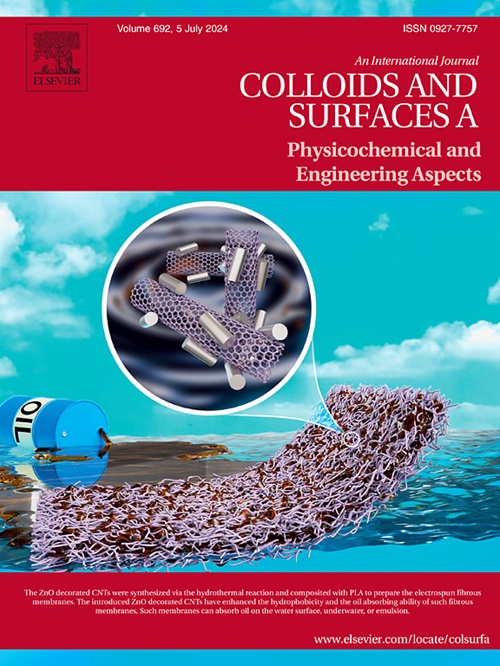A novel in situ green method for synthesizing a palladium NPs-based catalyst aimed at the selective hydrogenation of aldehydes in cinnamaldehyde
IF 4.9
2区 化学
Q2 CHEMISTRY, PHYSICAL
Colloids and Surfaces A: Physicochemical and Engineering Aspects
Pub Date : 2025-04-27
DOI:10.1016/j.colsurfa.2025.137035
引用次数: 0
Abstract
In the first study, Palladium nanoparticles (NPs) were synthesized via wet impregnation of hybrid hydroxyapatite nanomaterials using a sodium tetrachloropalladate dihydrate (Na2PdCl4·2 H2O) precursor. Citrate served as active sites to facilitate the selective and "in situ" reduction of palladium NPs. To investigate the role of citrate, hybrid hydroxyapatite (nCit-HAp) nanomaterials were prepared by varying the molar ratio of citrate to HAp (n = 0.2, 0.4, and 0.8). The resulting (PdNPs/nCit-Hap) catalysts were characterized using techniques such as N2 adsorption-desorption, ICP-OES, IR-ATR, X-ray diffraction, TEM and XPS. The second study, focused on the effects of parameters like the Cit/HAp molar ratio and heat treatment on the selective hydrogenation of. The Pd/0.8Cit-HAp catalyst demonstrates remarkable performance in the selective hydrogenation of cinnamaldehyde, achieving approximately 90 % selectivity toward cinnamyl alcohol and 100 % conversion. This enhanced selectivity is attributed to the presence of small palladium nanoparticles (∼2.7 nm) with surface electropositive Pd2 + sites, as identified by X-ray photoelectron spectroscopy (XPS). These Pd2+ sites, stabilized by citrate functionalization, promote preferential adsorption and polarization of the carbonyl (C![]() O) group, thereby directing the reaction pathway toward the desired unsaturated alcohol. The observed structure sensitivity in the hydrogenation of C
O) group, thereby directing the reaction pathway toward the desired unsaturated alcohol. The observed structure sensitivity in the hydrogenation of C![]() O versus C
O versus C![]() C bonds, along with the intrinsic activities (TOF), was attributed to size-dependent effects of palladium particles, which were controlled by the citrate groups on the hydroxyapatite surface.
C bonds, along with the intrinsic activities (TOF), was attributed to size-dependent effects of palladium particles, which were controlled by the citrate groups on the hydroxyapatite surface.
一种新的原位绿色合成钯nps基催化剂,旨在肉桂醛中醛的选择性加氢
在第一项研究中,以四氯丙酸钠二水合物(Na2PdCl4·2 H2O)为前驱体,通过湿浸渍法制备了杂化羟基磷灰石纳米材料。柠檬酸盐作为活性位点,促进钯NPs的选择性和“原位”还原。为了研究柠檬酸盐的作用,通过改变柠檬酸盐与羟基磷灰石的摩尔比(n = 0.2,0.4和0.8)制备了杂化羟基磷灰石(ncitt -HAp)纳米材料。采用N2吸附-解吸、ICP-OES、IR-ATR、x射线衍射、TEM和XPS等技术对制备的PdNPs/nCit-Hap催化剂进行了表征。第二部分研究了Cit/HAp摩尔比和热处理等参数对Cit/HAp选择性加氢的影响。Pd/0.8Cit-HAp催化剂对肉桂醛的选择性加氢表现出优异的性能,对肉桂醇的选择性约为90% %,转化率为100% %。通过x射线光电子能谱(XPS)鉴定,这种增强的选择性归因于具有表面电正电荷Pd2 +位点的小钯纳米颗粒(~ 2.7 nm)的存在。这些Pd2+位点被柠檬酸官能化稳定,促进羰基(CO)基团的优先吸附和极化,从而将反应途径导向所需的不饱和醇。观察到的CO与CC键加氢的结构敏感性,以及固有活性(TOF),归因于钯颗粒的尺寸依赖效应,这是由羟基磷灰石表面的柠檬酸基团控制的。
本文章由计算机程序翻译,如有差异,请以英文原文为准。
求助全文
约1分钟内获得全文
求助全文
来源期刊
CiteScore
8.70
自引率
9.60%
发文量
2421
审稿时长
56 days
期刊介绍:
Colloids and Surfaces A: Physicochemical and Engineering Aspects is an international journal devoted to the science underlying applications of colloids and interfacial phenomena.
The journal aims at publishing high quality research papers featuring new materials or new insights into the role of colloid and interface science in (for example) food, energy, minerals processing, pharmaceuticals or the environment.

 求助内容:
求助内容: 应助结果提醒方式:
应助结果提醒方式:


